Driving down from Barcelona to Granada was a road trip for the books.
Ever since I read The Alchemist by Paulo Coelho, I fell in love with the word “Andalusia.” It’s not just a name, but a place woven with dreams—the land where the shepherd boy Santiago set out to seek his fortune, where an old church crumbles into ruins, and sheep wander in search of greener pastures. Some words become part of our very being, rooted in the books we read, the films we cherish, or the legends we are told. We hold these names so close that they eventually grow into a quiet longing. For me, just as “Pensacola” and “Avignon” have nestled into my heart, “Andalusia” holds a special place in my soul. Spain was always on my travel list, but it was never the bustling streets of Barcelona or the grandeur of Madrid that called to me—it was always Andalusia.
It took a lot of convincing to choose Granada over Madrid, but we made it. With all the legends and history of the Moors and the Christian Reconquista, we could not skip Granada and the Alhambra. I came back with a promise to return—this time with more time to explore further south and maybe even spend a few weeks there.
Alhambra
Alhambra is a historic palace complex located in Granada, Spain. Situated high on a hill, the complex is one of the most significant examples of Islamic architecture in the world. As I mentioned in my Spain blog, the Iberian peninsula was occupied by Muslims(Moors) from northern Africa roughly between the 8th and 15th centuries. Granada was the capital of the Moorish empire and the last stronghold of Islamic rulers in Europe before the Christians overthrew them in the 15th century.

During the rule of the Moors, they built a beautiful fort and palace complex called Alhambra that stands to this day in its great glory. One point to appreciate while visiting this place is how well the area is preserved. No one destroyed what their predecessors built; instead, they used it, expanded it, and made it more beautiful – a lesson for us to learn in these modern times.
I had picked up Tales of the Alhambra by Washington Irving to read before the trip . I was not disappointed as I found myself connecting and filling blanks of the stories our tour guide had to share- felt like a local although I am sure my excitement annoyed our guide considerably. Most of the information I am sharing here is from the book and the narrations of the guides. For us, this was the highlight of our trip and if you visit Spain, this place should not be missed.
Some History
711 AD: The Moorish Invasion of the Iberian Peninsula The Moors, who were Muslim Berbers and Arabs from North Africa, crossed the Strait of Gibraltar and conquered the Iberian Peninsula, which includes modern-day Portugal and Spain.
8th–15th Centuries: Multiple Islamic Dynasties Built and Expanded the Alhambra
- 8th–9th Century: Early Moorish Rule: The region became part of the vast territory known as Al-Andalus, with Córdoba as its capital. Granada was initially a small and unremarkable settlement but began to gain importance over time.
- 11th Century: Zirid Dynasty and Development of the City: The Zirid Dynasty, originally from North Africa, established Granada as an independent taifa kingdom after the fall of Córdoba.
- 12th Century: Almoravid and Almohad Rule: The Almoravids, a Berber Muslim dynasty from North Africa, invaded the Iberian Peninsula to unify the taifa kingdoms under strict Islamic rule. Granada came under their control in 1090.
- 13th Century: The Nasrid Dynasty: Muhammad I Ibn al-Ahmar established the Nasrid Dynasty in 1232, making Granada the capital of a prosperous emirate. This marked the beginning of a golden age for the city. Muhammad I fortified the city, laid the foundations for the Alhambra, and secured alliances that maintained Nasrid rule.
- 14th Century: This period saw Granada reach its zenith as a center of art, scholarship, and architectural achievement.
- 15th Century: Decline of the Nasrid Dynasty due to internal conflicts and power struggles.
1492: The Fall of Granada and the Christian Reconquista Muhammad XII (Boabdil), the last Nasrid ruler, surrendered the city to King Ferdinand II of Aragon and Queen Isabella I of Castile. This event marked the end of Muslim rule in Spain and the conclusion of the Reconquista.
16th Century: Aftermath The aftermath included the forced conversion of Muslims (now called Moriscos) to Christianity. By 1609, most of the Muslim population had been expelled or eradicated from Granada.
The Legends
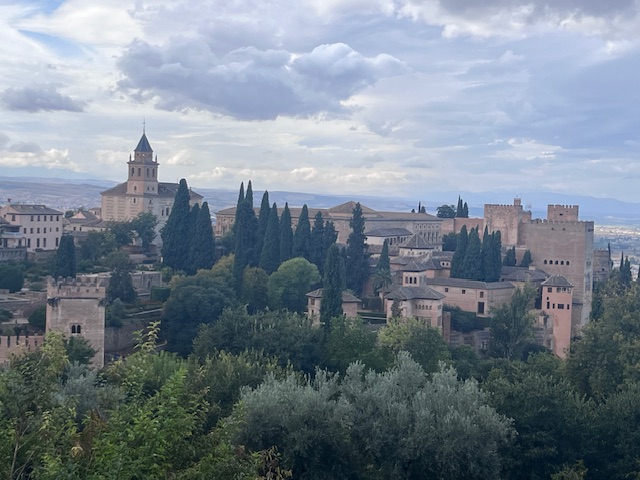
We took a nights tour of Alhambra called the legends of Alhambra. These are stories shared by the guide and also some from the books I read on my way.
As you know I am always fascinated by stories, whether real or made up, when they are passed on from generation to generation , it adds a charm and you wonder which part of this is real. Did the princess really kiss the frog or did the prince kiss the princess without consent ??
Abencerrages Family
Abencerrages, is the story of a noble Muslim family. It is said that the sultan at the time, jealous of one of the Abencerrages who had allegedly fallen in love with his beloved, invited the entire family to a feast in the Hall of the Abencerrages. There, he ordered their massacre, and the legend holds that their blood stained the fountain in the hall, which can still be seen today. You can see the tree under which the lovers met in the garden. as it exists to this day. The floor is made of red stones- cannot beat the power of Clorox and some arm grease!
The Moor’s Last Sigh(Not Salman Rushdie’s novel)
One of the most poignant stories tied to the Alhambra is that of Boabdil(Muhammad XII), the last Nasrid ruler of Granada. According to legend, after surrendering the Alhambra to the Catholic Monarchs, King Ferdinand and Queen Isabella, Boabdil was exiled. As he left, he paused at a hill now known as El Suspiro del Moro (The Moor’s Sigh) to take one last sorrowful look at his beloved city and palace. His mother, Aixa (Aisaha), is said to have scolded him with the words, “You weep like a woman for what you could not defend like a man.” (Mean wives are legendry, try that at home). This heart-wrenching tale symbolizes the fall of Muslim rule in Spain and the deep loss of the Alhambra.
Sultan’s Fountain of Tears
The Court of the Lions is one of the most iconic areas of the Alhambra. One legend suggests that the central fountain, supported by twelve marble lion statues, was a gift from a Jewish vizier to a sultan. The story goes that these lions once came to life, roaring whenever betrayal or treachery was near. Some versions of the story say the lions wept when they sensed the sorrow and tears of the sultan, who had lost a loved one.
Princess Zoraya
The Torre de la Cautiva (Tower of the Captive) is named after the legend of a beautiful princess who was held captive in the tower. Some stories identify her as Zoraya(Suraiyya), the Christian wife of Sultan Muley Hacén (Boabdil’s father), who was said to be deeply loved by him, sparking jealousy and conflict within the palace.
Hidden Treasure
According to folklore, there is a hidden treasure buried deep within the Alhambra, guarded by the spirit of an enchanted princess. It is said that only someone who is pure of heart and possesses immense courage can uncover this hidden wealth. Gypsies in the area were known to recount tales of the treasure, embellishing it with dreams of fortune and adventure.
Pact with the devil
I rulers who built the fortress made a pact with the devil so that the fortres swould survive the tests of time. The area has had numerous earth quakes over the years which never affeted Alhambra because of this pact.
Three Beautiful Sisters
This tale centers on three sisters who lived within the Alhambra under the watchful eye of their father, a sultan. They fell in love with three Christian soldiers(Knights) who managed to enter the fortress in disguise. The three sisters decided to elope with the Knights but the youngest had a change of heart and told the king of their plans. The lovers’ meetings were discovered, leading to the murder of the sisters as well as the soldiers, and it is said that the whispers of their story can still be felt in the soft wind through the courtyards.
Ghost of the Alhambra
Some visitors and night guards claim to have seen the shadowy figure of a woman dressed in Moorish clothing wandering the halls of the Alhambra, particularly around the Court of the Myrtles and the Hall of the Ambassadors. The spirit is believed to be that of a sultan’s concubine who died of a broken heart. Her presence is said to be gentle, filled with longing for the lost days of grandeur and love.
Places to see
A word of caution: you definitely need a tour guide to visit the Alhambra. Tickets sell out about a month in advance. A pro tip that our guide shared is that the tourism center releases unsold tickets at 11:00 PM the day before—so put your name on the waiting list even if you fail to get tickets. The timing is quite strict, so follow all instructions carefully to ensure you make it.

Washington Irving: The Alhambra was in ruins and was used by homeless people until it was revived to the state it is in now. Washington Irving traveled to the area and wrote about this place, bringing it to the world’s attention. Stop by his statue on the way in. By the way, this is the same Irving who wrote Rip Van Winkle and The Legend of Sleepy Hollow.

The Alcazaba: This fortress section of the complex, dating back to the 9th century, served as a military stronghold. Climb the towers for stunning panoramic views of Granada and the Sierra Nevada mountains. Note the bear pit in the center of the complex—there is a well and cistern underneath that supplied water to the area. Also, take note of the large round boulders and pockmarks on the walls, which are all indicators of the bloody battles that took place here.
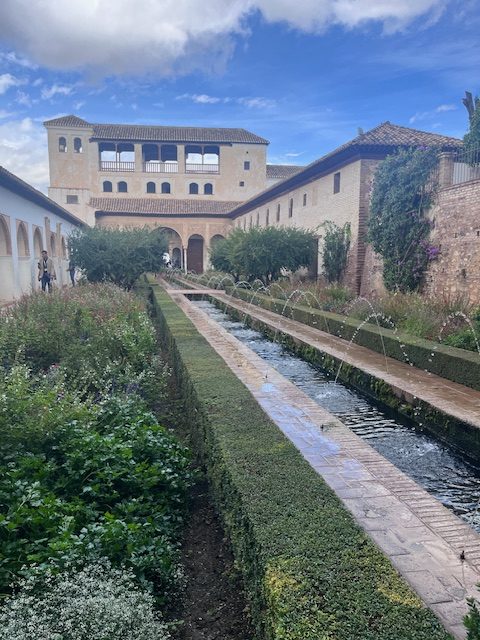
Nasrid Palaces: Visit for the intricate and beautiful Moorish architecture. All the legends mentioned above are part of this place.
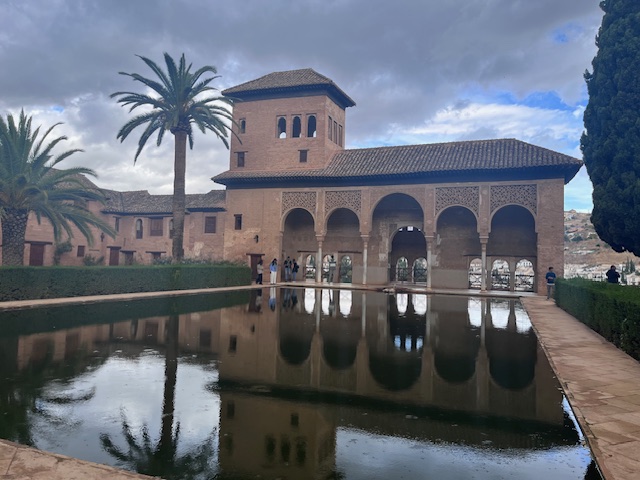
Generalife: The summer palace of the sultan and its gardens. It is just a short distance from the main palace, so the significance of calling it a summer home might seem unclear—perhaps because they didn’t know about Hawaii back then. The place is beautiful, with lots of trees, plants, well-manicured gardens, and fountains. Generalife is called “the architect’s garden,” with the architect being the supreme creator, God.

Palace of Charles V: This building features a completely different architectural style and is one of the newer structures in the complex. It is an unfinished palace built by Charles V, with a magnificent square exterior and a circular interior space. This is one of the most photographed spots in the complex—I may have gone overboard with photos, and my tour mates affectionately nicknamed me “selfie queen” due to my enthusiasm for capturing the most beautiful shot under the moonlight.
There are many more places in the complex; leave it to your tour guide to fill in the details.
Outside of the Alhambra
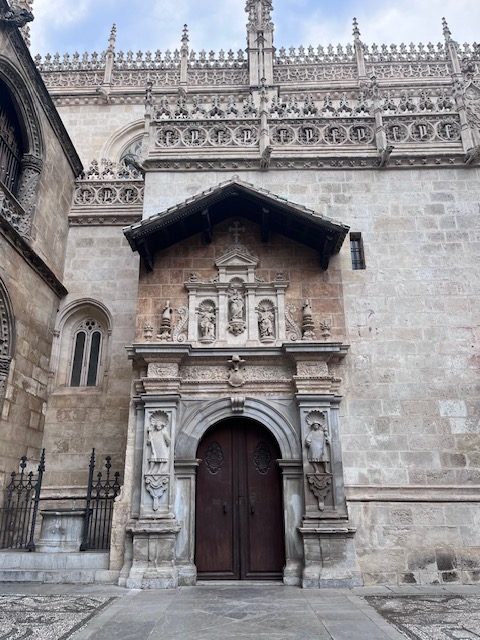
Granada Cathedral: Visit the cathedral to see the tomb of King Ferdinand and Queen Isabella.
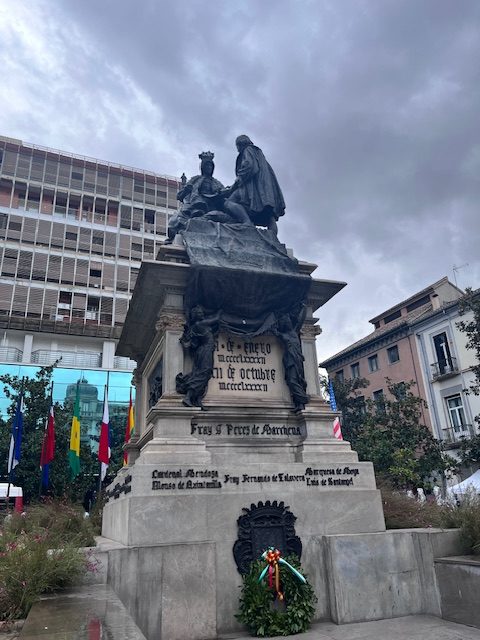
Statue of Columbus: Located in the city center, it’s a great spot for photos.
Sacromonte: The gypsy district (I was surprised that this term is not considered derogatory in Granada as it is in the U.S.) and flamenco performances.
Albaicín Neighborhood: We didn’t spend much time here, but if you’re looking for narrow streets and beautiful village views, it’s worth a visit.
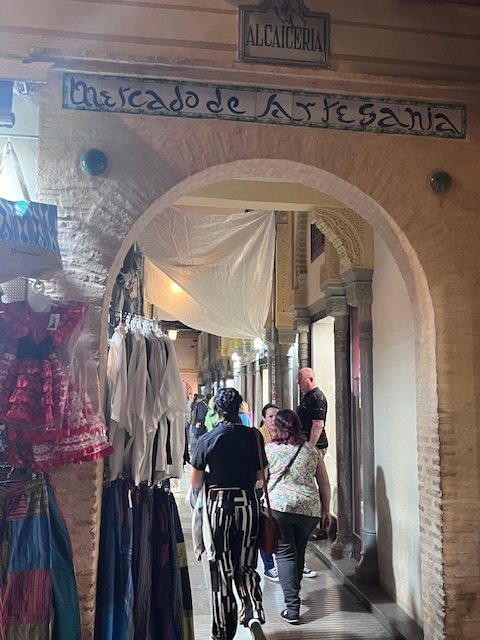
Bazaars: Perfect for satisfying your shopping cravings.
Streets and pavements: Note the unique mosaic pavements on the ground with stone inlays, another contribution of Islamic architecture.
Pomegranates: Granada is the Spanish term for pomegranate. You will see the images everywhere especially all over Alhambra. The main gate of Alhambra is called the pomegranate gate
Books to Read
Tales of the Alhambra by Washington Irving
Alchemist By Paulo Coehlo
Notes
- Book all tickets in advance: They sell out about a month early. A pro tip from our guide is that the tourism center releases unsold tickets at 11:00 PM the day before—so put your name on the waiting list even if you don’t secure tickets initially. The timing is quite strict, so follow all instructions closely to ensure entry.
- Good tapas: In most places, one tapa comes free with a drink.
- Extremely mountainous: Bring sturdy, comfortable shoes.
- Small city: You can cover most of it on foot.
- Best time to visit: Fall or spring, as the area can get quite humid.